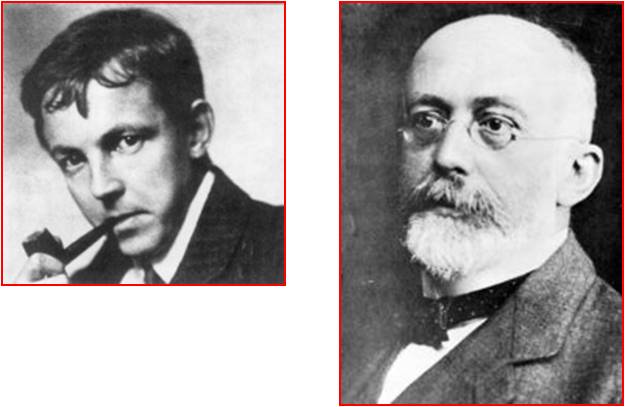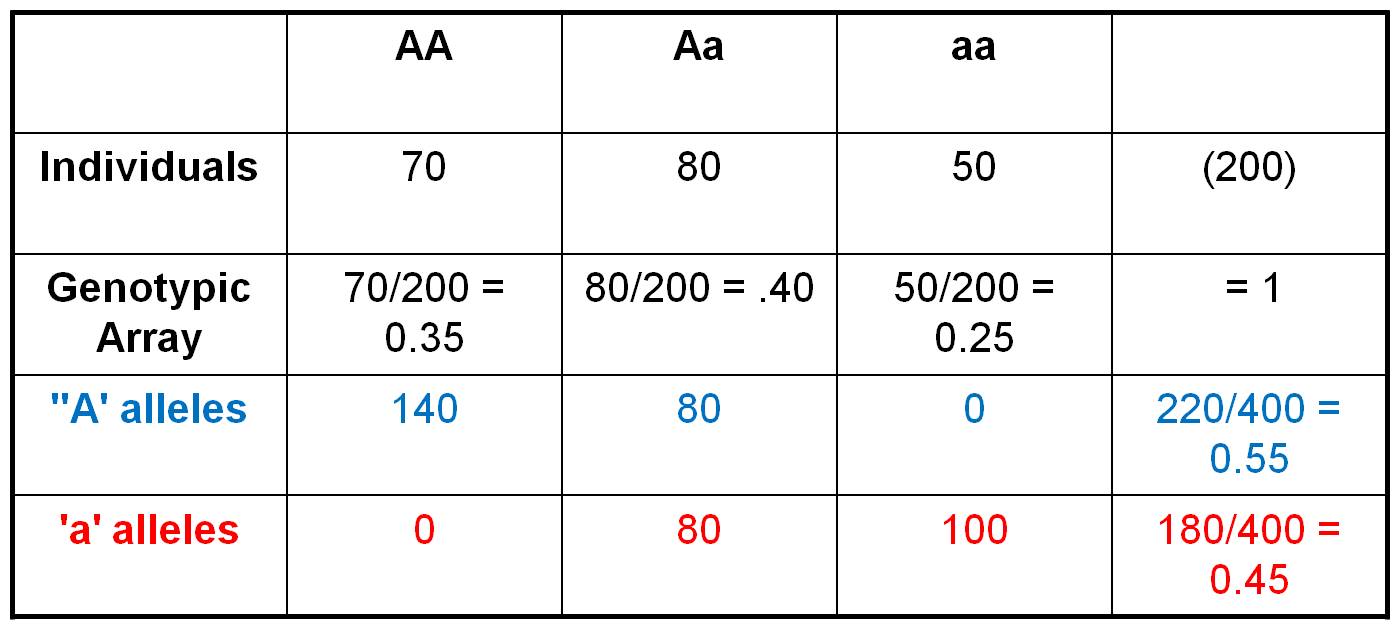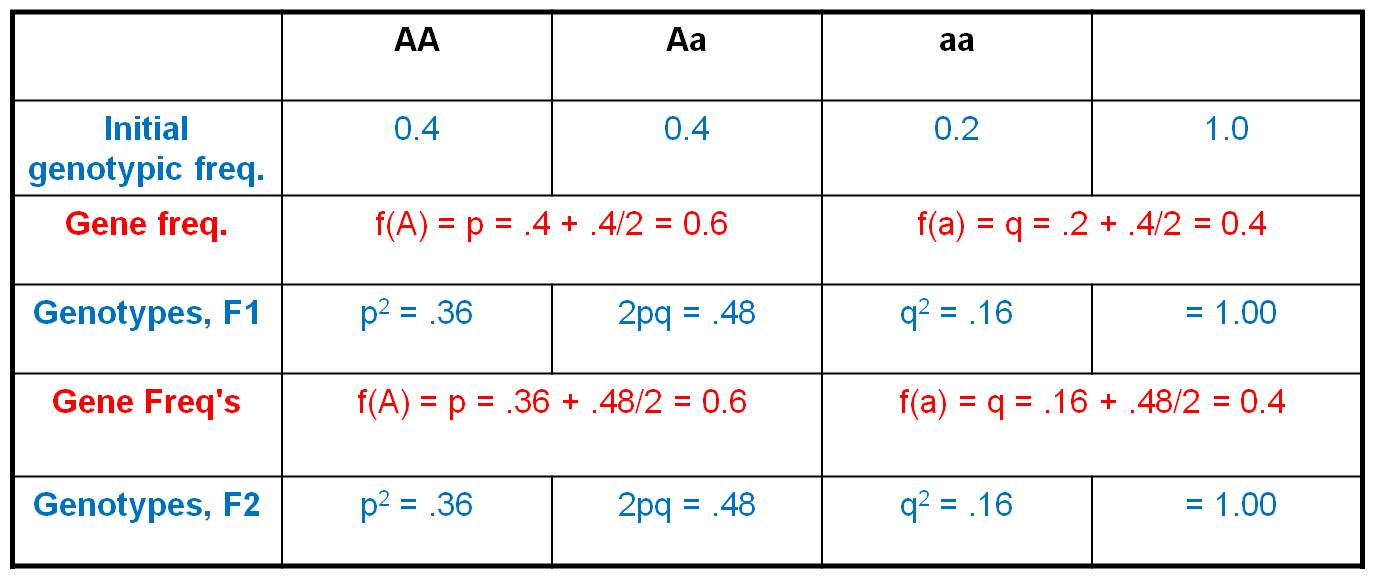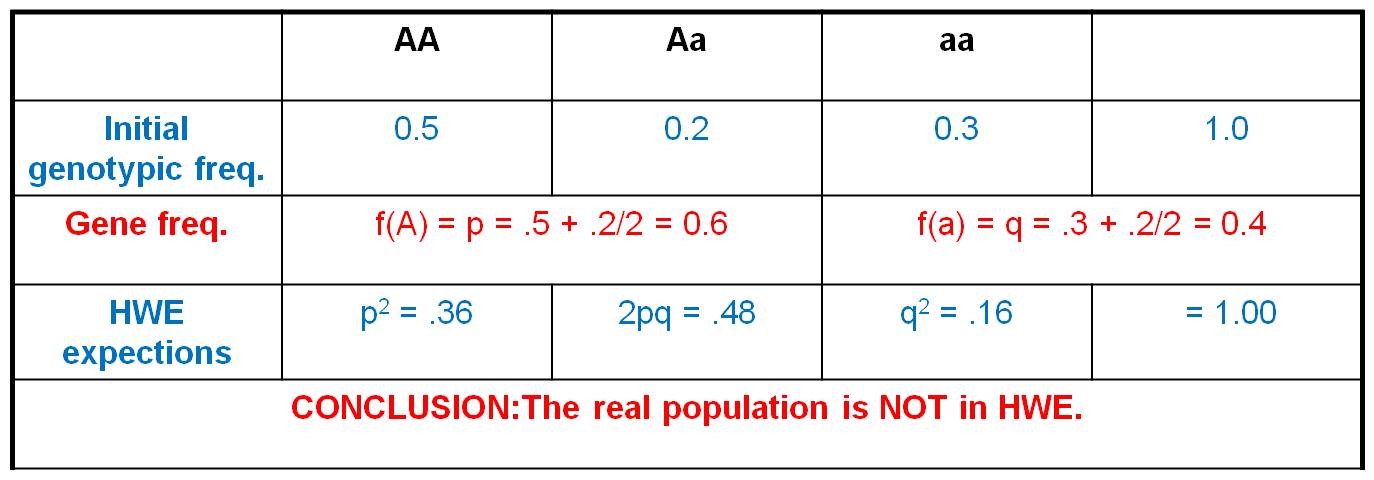Modern Evolutionary Biology
I. Population Genetics
A. Overview
As a consequence of our modern understanding
of heredity and genetics, we have learned quite a bit about variation AND evolution,
and our model, a this point in the class is:
Sources of Variation
Agents of Change
MUTATION:
-New Genes:
Natural Selection
point mutation
Mutation (polyploidy can make new species)
RECOMBINATION:
- New Genes:
exon shuffling
-New Genotypes:
-crossing over
- independent assortment
 In
the early 20th century, at the same time that T. H. Morgan was studying mutations
and creating linkage maps, other biologists were considering the evolutionary
implications of this new knowledge regarding genetic variation. They appreciated
that individuals do not evolve - evolution is a process that occurs at the population
level. For example, as a consequence of differential reproductive success among
individuals in a population, the range of phenotypes and their relative frequencies
in the population will change over time. Individuals are born, life, reproduce
(maybe) and die. As a result of passing on their genes at different frequencies,
the genetic structure of the population changes over time (evolution). Two biologists,
G. Hardy and W. Weinberg, constructed a model to explain how the genetic structure
of a population might change over time.
In
the early 20th century, at the same time that T. H. Morgan was studying mutations
and creating linkage maps, other biologists were considering the evolutionary
implications of this new knowledge regarding genetic variation. They appreciated
that individuals do not evolve - evolution is a process that occurs at the population
level. For example, as a consequence of differential reproductive success among
individuals in a population, the range of phenotypes and their relative frequencies
in the population will change over time. Individuals are born, life, reproduce
(maybe) and die. As a result of passing on their genes at different frequencies,
the genetic structure of the population changes over time (evolution). Two biologists,
G. Hardy and W. Weinberg, constructed a model to explain how the genetic structure
of a population might change over time.
Their model begins by constructing
an 'equilibrium' model - a model of what the genetic structure would look like,
and how it would behave, if there was NO CHANGE over time. (We can liken this
to a "statistical null hypothesis of no effect"). Then, an actual
population is compared to this model, to see whether the population is evolving
or not.
B. The Genetic Structure of a Population
Our first step is to describe the
genetic structure of a population; we need to do this before we can model what
it would do over time. The genetic structure of a population is defined by the
gene array and the genotypic array. To understand what these are, some definitions
are necessary:
1. Definitions:
- Evolution: a change in the genetic structure of a population
- Population: a group of interbreeding organisms that share
a common gene pool; spatiotemporally and genetically defined
- Gene Pool: sum total of alleles held by individuals in a population
- Genetic structure: Gene array and Genotypic array
- Gene/Allele Frequency: % of alleles at a locus of a particular
type
- Gene Array: % of all alleles at a locus: must sum to 1.
- Genotypic Frequency: % of individuals with a particular genotype
- Genotypic Array: % of all genotypes for loci considered;
must = 1.
2. Basic
Computations - Determining
the Genotypic and Gene Arrays:
 The
easiest way to understand what these definitions represent is to work a problem
showing how they are computed.
The
easiest way to understand what these definitions represent is to work a problem
showing how they are computed.
Consider the population shown to
the right, in which there are 70 AA individuals, 80 heterozygotes, and 50 aa
individuals. We can easily calculate the Genotypic Frequencies
by dividing each of these values by the total number of individuals in the population.
So, the Genotypic Frequency of AA = 70/200 = 0.35. If we account
for all individuals in the population (and haven't made any careless math errors),
then the three genotypic frequencies should sum to 1.0. The Genotypic
Array would list all three genotypic frequencies: f(AA) = 0.35,
f(Aa) = 0.40, f(aa) = 0.25. A Gene Frequency is the
% of all genes in a population of a given type. This can be calculated two ways.
First, let's do it the most obvious and direct way, by counting the alleles
carried by each individual. So, there are 70 AA individuals. Each carries 2
'A' alleles, so collectively they are 'carrying' 140 'A' alleles. The 80 heterozygotes
are each carrying 1 'A' allele. And of course, the 'aa' individuals aren't carrying
any 'A' alleles. So, in total, there are 220 'A' alleles in the population.
With 200 diploid individuals, there are a total of 400 alleles at this locus.
So, the gene frequency of the 'A' gene = f(A) = 220/400 = 0.55.
We can calculate the frequency of the 'a' alleles the same way. The 50 'aa'
individuals are carrying 2 'a' alleles each, for a total of 100 'a' alleles.
The 80 heterozygotes are each carrying an 'a' allele, and the 140 AA homozygotes
aren't carrying any 'a' alleles. So, in total, there are 180 'a' alleles out
of a total of 400, for a gene frequency f(a) = 180/400 = 0.45. The gene
array presents all the gene frequencies, as: f(A) = 0.55, f(a)
= 0.45.
There is a faster way to calculate
the gene frequencies in a population than adding up the genes contributed by
each genotype. Rather, you can use these handy formulae:
f(A) = f(AA) + f(Aa)/2
f(a) = f(aa) + f(Aa)/2
So, to calculate the frequency of
a gene in a population, you add the frequency of homozygotes for that allele
with 1/2 the frequency of heterozygotes. In our example, this would be:
f(A) = 0.35 + 0.4/2 = 0.35 + 0.2
= 0.55
f(a) = 0.25 + 0.4/2 = 0.25 + 0.2
= 0.45
Wow... that's a lot faster.
C. The Hardy-Weinberg
Equilibrium Model
1. Goal:
The goal of the "Hardy-Weinberg
Equilibrium Model" (HWE) is to describe what the genetic structure of the
population would be if NO evolutionary change occurs. Working independently,
Hardy and Weinberg realized
that the gene frequencies in a population will NOT change - will remain in EQUILIBRIUM
- if the following conditions are met:
- there is random mating
- no selection
- no mutation
- no migration
- and the population is infinitely
large.
And, they realized that a population
will reach an equilibrium in GENOTYPIC frequencies, too, after one generation
of meeting these expectations. And, for as long as these conditions are met,
a population will NOT EVOLVE. Let's see how they came by these conditions.
 2.
Example:
2.
Example:
Consider an initial population, with
a genotypic array as shown. The gene frequencies are:
A = 0.4 + (0.4/2) = 0.6
a = 0.2 + (0.4/2) = 0.4
Now, consider this gene pool in which
60% of the alleles are 'A' and 40% of the alleles are 'a' (as defined by the
gene frequencies). The gene frequencies represent the frequencies of gametes
carrying these gens; so 60% of sperm are 'A', 40% are 'a', and likewsie for
eggs.
So, now we employ the HWE model.
IF the population mates at random, then we can use the product rule to determine
the probability of any two gametes coming together. The propability that and
'A' sperm fertilizes an 'A' egg = 0.6 x 0.6 = 0.36. And of course, this is the
only way to produce an 'AA' zygote. The frequency of 'AA' zygotes (the F1 offspring)
produced by this population should be 0.36. Likewise, the probability that an
'a' sperm fertilizes an 'a' egg = 0.4 x 0.4 = 0.16. And again, this is the only
way to make an 'aa' zygote, so the total frequency of 'aa' zygotes in the F1
will be 0.16. Now, there are two ways to make an 'Aa' zygote: an 'A' sperm can
fertilize an 'a' egg (probability = 0.6 x 0.4 = 0.24), and an 'a' sperm can
fertilize an 'A' egg (also with a probability of 0.4 x 0.6 = 0.24). So, the
total frequency of Aa zygotes in the F1 will be 2 x 0.24 = 0.48. If we generalize,
and let f(A) = p and f(a) = q, then the genotypic frequencies under HWE can
be calculated as: f(AA) = p2, f(Aa) = 2pq, and f(aa) = q2.
What is the genetic structure of
the population in the F1? Well, f(A) = f(AA) + f(Aa)/2 = 0.36 + 0.48/2 = 0.36
+ 0.24 = 0.6. And, f(a) = f(aa) + f(Aa)/2 = 0.16 + 0.48/2 = 0.4. So, the gene
frequencies did not change. And, if these organisms produce gametes at these
gene frequencies and mating is random, then F2 zygotes should be formed at the
frequencies of f(AA) = 0.36, f(Aa) = 0.48, and f(aa) = 0.16. Look familiar?
Indeed, after one generation of random mating, the population has reached an
EQUILIBRIUM - constant gene and genotypic frequencies over time.
Now, of course, these calculations
will only be true IF the population mates at random. AND, they will only be
true if there is no mutation. If 'A' alleles are mutating into 'a' alleles,
then the gene frequencies will not be 0.6 and 0.4, and calculations based on
these numbers will not be correct. So, we must assume NO MUTATION. Likewise,
we can't have any migration; we can't have 1000 AA individuals migrate into
our population, or that would change the gene frequencies, too; and our predictions
based on frequencies of 0.6 and 0.4 would be incorrect. So, we must assume NO
MIGRATION, too.
So, at this point we have zygotes
at the frequencies shown in the "Genotypes, F1" row. In order for
there to be no change in the genetic structure of the population, there must
be NO SELECTION. In other words, all genotypes must have the same probability
of survival and reproduction. Only then will they contribute gametes at frequencies
of p = 0.6 and q = 0.4. (If there were selection, and if AA individuals were
the only zygotes to survive to reproduce, for instance, then the gene frequencies
would change and our predictions based on frequencies of 0.6 and 0.4 would not
be correct).
And finally, this model will only
be explicitly true for populations that are infinitely large: because that is
the only time when we can be garaunteed that predictions based on random chance
will be exactly met. (Think about it this way... suppose I give you a coin that
is absolutely perfectly balanced. It IS PERFECTLY BALANCED. And suppose I ask
you, "how many times do you have to flip that coin to be ABSOLUTELY SURE
of producing a 50:50 ratio of heads to tails? Well, if you only flip it four
times, you know that, just by chance, you would often get 3 heads and a tail
or 3 tails and a head. And even if you flip it 10,000 times, you might get 5001
heads and 4999 tails, even though the coin is perfectly balanced. To be absolutely
garaunteed that the predictions of this probabilisitic model will be met
exactly, you must flip the coin an infinite number of times. Obviously, this
is a theoretical constraint because no population is infinitely large. But this
is a theoretical model of no change, so we can employ theoretical expectations.
The same is true of our 'expectation' of a perfectly balanced coin - this expectation
will only be met, for sure, in an infinitely large sample. Yet we continually
employ that expectation for a perfectly balanced coin, even in finite samples.
So, if you flip the coin 20 times, how many heads would you expect? Your answer
of 10 is a theoretical expectation.
So, that is why these assumptions
exist. It is only when ALL these are met that the genetic structure of a population
will not change. It is only when ALL these assumptions are met that a population
will NOT evolve. Wow. That should seem rather amazing. It is only when these
assumptions are ALL met that a population WON'T change. If any of these assumptions
is not met, a population's genetic structure WILL change... and that is evolution.
So, from this analysis, we should expect populations to evolve - it is only
under a rare combination of events (no, mutation, no selection, no migration,
random mating, and an infinitiely large population) that evolution WON'T happen.
3. Utility
- If no real populations can explicitly
meet these assumptions, how can the model be useful? For instance, no
real population is infinitely large, so how can the model be useful? We
use it for COMPARISON. This model describes what the genotypic frequencies
should be IF the population was in equilibrium.
If the real genotypic frequencies are not close to these expectations, then
the population is not in HWE.... it is evolving. And if a population is not
in HWE, then the population must be violating one of the assumptions of the
HWE model. Think about that. The HWE is only 'true' if all the assumptions
are being met. If your real population differs from the model, then one
of the assumptions must not apply to your real population. This narrows
your focus on WHY the real populations isn't behaving randomly... and it might
identify WHY the population is evolving.... which is a biologically interesting
question.
 -
Again, the coin analogy applies. No REAL coin is probably exactly perfectly
balanced. But, if I give you a coin and ask you how balanced it is, you flip
it a few times and compare its behavior to WHAT YOU WOULD EXPECT FROM A PERFECT
COIN (50:50 RATIO). Even though a perfectly balanced coin may not exist, we
can use this theoretical model as a benchmark, to compare the behavior of real
coins. Many real coins act in a manner that is consistent enough with
the expectations from a perfectly balanced coin that we are willing to use them
AS IF they were perfectly balanced. The Hardy Weinberg Equilibrium
Model is the same... it is a theoretical model of no change against which we
can measure real populations.
-
Again, the coin analogy applies. No REAL coin is probably exactly perfectly
balanced. But, if I give you a coin and ask you how balanced it is, you flip
it a few times and compare its behavior to WHAT YOU WOULD EXPECT FROM A PERFECT
COIN (50:50 RATIO). Even though a perfectly balanced coin may not exist, we
can use this theoretical model as a benchmark, to compare the behavior of real
coins. Many real coins act in a manner that is consistent enough with
the expectations from a perfectly balanced coin that we are willing to use them
AS IF they were perfectly balanced. The Hardy Weinberg Equilibrium
Model is the same... it is a theoretical model of no change against which we
can measure real populations.
If HWE can be assumed, then the frequency
of recessive diseases can be assumed to equal q2, and the frequency of carriers
in the population can be estimated like this:
1) The frequency of hemachromatosis
worldwide is 1/450. If we assume that hemochromatosis is caused by a recessive
gene (q), and if we assume the population is in HWE with respect to this trait,
then q2 = 1/450 = 0.002. So, we take the square-root of both sides
to find q = 0.047. Well, if q = 0.047, and if p + q = 1, then p = 1 - 0.047
= 0.953.
2) If q = 0.047 and p = 0.953, then
the frequency of heterozygous carriers = 2pq = 0.09. So, we estimate that 9%
of the population are carriers.
Now, you might say, "but we
just determined that HWE would be unusual; so why would we assume it is
true for a given gene?" Well, a deleterious gene has already been
largely weeded out of a population, so selection against the few alleles that
are left is really weak. Indeed, this condition may not influence reproductive
success, anyway (NO SELECTION). In addition, we don't select mates based on
whether they have hemochromatosis (I bet you NEVER asked your date if they have
hemochromatosis, for example!!), so we can assume there is RANDOM MATING in
the population with respect to this trait. And although the human population
is not infinite, it is really big (~7 BILLION), so the effect of sampling error
is probably very small. Mutation is very rare, so the effects of mutation are
likely to be very small. And if we are making an estimate based on the whole
human population, then there can be no 'migrants' coming in from somewhere else
(Martians?). So, in some cases, we can reasonably assume a population might
be in HWE for a given gene. Of course, we could be wrong... and we would test
that prediction by sampling individuals in the population and determining the
frequency of heterozygotes genetically. But at least we would have a working
hypothesis.
Study Questions:
1.
What are the five assumptions of the Hardy-Weinberg Equilibrium Model?
2.
Consider the following population:
| |
AA |
Aa |
aa |
| Number
of Individuals |
60 |
20 |
20 |
- -
calculate the genotypic frequencies.
- -
calculate the gene frequencies
- -
calculate the HARDY WEINBERG EQUILIBRIUM frequencies.
3.
If the HWE model does not describe any real population, how can it be useful?
 In
the early 20th century, at the same time that T. H. Morgan was studying mutations
and creating linkage maps, other biologists were considering the evolutionary
implications of this new knowledge regarding genetic variation. They appreciated
that individuals do not evolve - evolution is a process that occurs at the population
level. For example, as a consequence of differential reproductive success among
individuals in a population, the range of phenotypes and their relative frequencies
in the population will change over time. Individuals are born, life, reproduce
(maybe) and die. As a result of passing on their genes at different frequencies,
the genetic structure of the population changes over time (evolution). Two biologists,
G. Hardy and W. Weinberg, constructed a model to explain how the genetic structure
of a population might change over time.
In
the early 20th century, at the same time that T. H. Morgan was studying mutations
and creating linkage maps, other biologists were considering the evolutionary
implications of this new knowledge regarding genetic variation. They appreciated
that individuals do not evolve - evolution is a process that occurs at the population
level. For example, as a consequence of differential reproductive success among
individuals in a population, the range of phenotypes and their relative frequencies
in the population will change over time. Individuals are born, life, reproduce
(maybe) and die. As a result of passing on their genes at different frequencies,
the genetic structure of the population changes over time (evolution). Two biologists,
G. Hardy and W. Weinberg, constructed a model to explain how the genetic structure
of a population might change over time.
 The
easiest way to understand what these definitions represent is to work a problem
showing how they are computed.
The
easiest way to understand what these definitions represent is to work a problem
showing how they are computed.
 2.
Example:
2.
Example:
 -
Again, the coin analogy applies. No REAL coin is probably exactly perfectly
balanced. But, if I give you a coin and ask you how balanced it is, you flip
it a few times and compare its behavior to WHAT YOU WOULD EXPECT FROM A PERFECT
COIN (50:50 RATIO). Even though a perfectly balanced coin may not exist, we
can use this theoretical model as a benchmark, to compare the behavior of real
coins. Many real coins act in a manner that is consistent enough with
the expectations from a perfectly balanced coin that we are willing to use them
AS IF they were perfectly balanced. The Hardy Weinberg Equilibrium
Model is the same... it is a theoretical model of no change against which we
can measure real populations.
-
Again, the coin analogy applies. No REAL coin is probably exactly perfectly
balanced. But, if I give you a coin and ask you how balanced it is, you flip
it a few times and compare its behavior to WHAT YOU WOULD EXPECT FROM A PERFECT
COIN (50:50 RATIO). Even though a perfectly balanced coin may not exist, we
can use this theoretical model as a benchmark, to compare the behavior of real
coins. Many real coins act in a manner that is consistent enough with
the expectations from a perfectly balanced coin that we are willing to use them
AS IF they were perfectly balanced. The Hardy Weinberg Equilibrium
Model is the same... it is a theoretical model of no change against which we
can measure real populations.